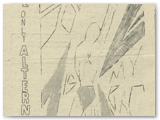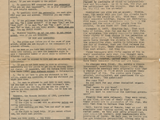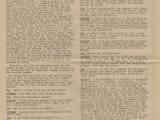Making a Paper:
The democratization of printing was one of the most important developments of the 1950s. With the invention of the mimeograph machine and offset printing, nearly anyone could print newspapers for a wide audience. These developments were so important in fact, that on the wall of the Students for a Democratic Society (SDS) headquarters hung a picture of a mimeograph machine with the words "Our Founder" underneath it. (McMillian, 13) Though running a newspaper still required funding and a great level of devotion, issues of these underground newspapers could be printed for around $350-500 an issue for 1,000 copies. With a little hard work and the support of enough people, newspapers could now be produced by a younger generation and aimed at this same group. (Glessing, 85)
The first three issues of The Only Alternative ranged from 6 to 8 pages. These were all made on a mimeograph machine and printed out of William and Sue Harriff's house at 309 South McKinley Avenue in Muncie. By the fourth issue, the paper had become popular enough to warrant moving production to a professional printer. In December 1968, The Only Alternative debuted its first professionally printed issue. This issue and the following twelve were printed in Scottsburg, Indiana by a man named Wade Mann. For the beginning of Volume III, TOA was forced to move to a different printer as Mann was forced out of business when it was reported that he was printing three underground newspapers at his shop. Because of this incident, TOA were reluctant to mention their printer for the final 3 volumes. While the first three issues probably had a small circulation and were printed in-house, they most likely had a low cost to produce. Even after the newspaper moved to a professional printer, it still had a below verge production cost, allowing TOA to be printed at a high volume, around 1,500 per issue. Since TOA was not in color and usually ran either 16 or 24 pages, it had a much lower cost than the average newspaper. A 16 page issue at 1,500 copies cost about $125 for TOA. Though this cost was low, it was not always easy to come up with the money. In fact, there were a few instances when the staff were not sure if there would be another issue. The cover of Vol. II No. 11 refers to it as the "36 page final issue" of TOA. (Daily News, January 8, 1970) While many underground publications were able to offset printing costs through selling advertisements and classified ads, TOA was not able to generate enough interest in those areas to help with costs, something discussed in greater detail here.
The following gallery illustrates the changes between the first two issues and Vol. I No. 4. The fourth issue of the newspaper shows how the more profession version of The Only Alternative compares to the mimeographed editions.





